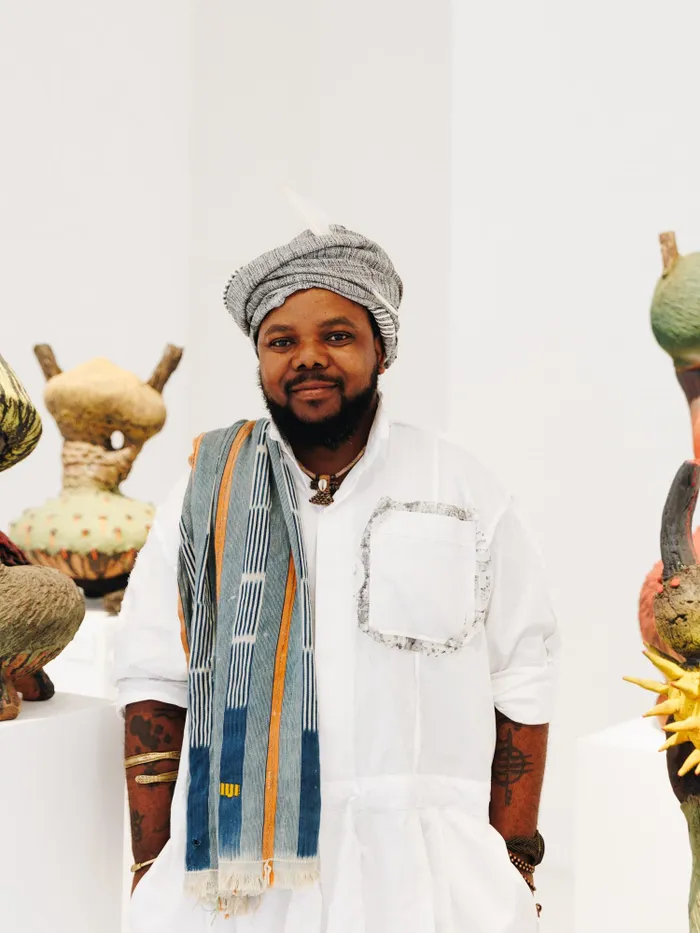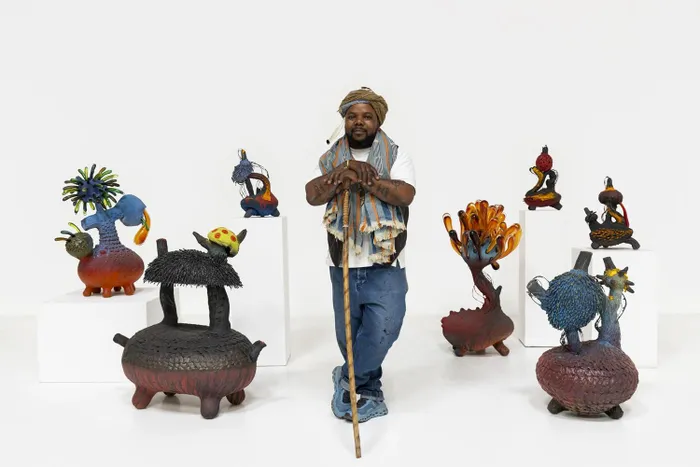When Ritual Becomes Performance: Reflecting on Andile Dyalvane exhibition

Majolandile “Andile” Dyalvane’s iNgqweji exhibition opened at the V&A Waterfront's Southern Guild art gallery.
Image: Supplied
It’s been years since I last felt the throb of a headache. Many many years ago. But this Saturday it hit me with the brute force of Mandoza's Nkalakatha, during the opening of Majolandile “Andile” Dyalvane’s iNgqweji exhibition at the V&A Waterfront's Southern Guild art gallery.
INgqweji is Xhosa for a bird's nest and the works on show teem with biomorphic earthenware forms, vivid colour and tactile materials such as free-blown glass and hand-forged copper. In some way or the other they all mimic large nests, which the artist observed while on a pilgrimage to the late Credo Mutwa's home in Kuruman.
The exhibition is an impressive body of work, complete with preliminary sketches and a video documenting the making process.
Andile Dyalvane is one of the continent's top ceramicists and the co-founder of IMISO Ceramics in Woodstock. He has exhibited all over the world including at the Met in New York, Los Angeles County Museum of Art, Pérez Museum, Denver Art Museum and Iziko South African National Gallery, to name just a few.
Dyalvane has been at this thing for over two decades and attributes his enduring success to his wife, Nkuthazo, who was present at the opening and stood by his side as he spoke about his work and how they met years ago on a train to Woodstock.
I am more a fan of Dyalvane's abstract figurative sculptures than of his vase-form pieces. I am a sucker for fluid, geometric, aesthetically pleasing work but recognise there’s a strong market and real enthusiasm for his broader body of work. You could hear it in the crowd’s delighted 'oohs' and 'aahs'. With some wanting to touch even.
Which brings me to my headache.

Andile Dyalvane is one of the continent's top ceramicists and the co-founder of IMISO Ceramics in Woodstock.
Image: Supplied
Part of the exhibition’s opening programme included a live performance by Dr Nkosenathi Koela. Just before the music began, Dyalvane performed a ritual involving the burning of impepho (sage) mixed with pieces of animal hide (I assume). Impepho is commonly used to cleanse a space, but it is also a medium for calling on spiritual connections. And that’s when things took a turn. The energy shifted. And my headache kicked in. I walked out for a breath of fresh air as the performance carried on and the invocations grew louder inside.
“I suppose impepho isn’t for everyone. Some people are highly spiritual and it might stir things in them. One might find themselves on the floor calling out their ancestors,” mused a former Cape Argus journalist who noticed my discomfort as I stepped out. She’s a fully fledged traditional healer in the Eastern Cape these days and good friends with Dyalvane, so I took her comment seriously. Even if it was said in jest.
As my headache intensified, it struck me that the use of impepho or the performance of rituals within what is labelled “African art” can come with some unknown risks. However performative the intention, the staging of African spirituality in public spaces like art galleries can border on trivialisation for entertainment (or read this as 'commercialisation') sake. Perhaps it might appeal to an outsider's gaze. Which I think it does. But for those who know its knowns, it feels like walking a tightrope. Where do we draw the line between ritual and performance art?
Make no mistake, I deeply admire Dyalvane’s craft. This Ngobozana-born artist is an inspiration to countless rural children and his success signals the need for more art galleries and creative spaces in the Eastern Cape. The fact that he must be based in Cape Town to thrive is one of the province’s missed opportunities. Still, in August this year, the Eastern Cape’s Department of Sport, Recreation, Arts and Culture honoured him with a 2025 Outstanding Crafter award.
What I like most about Dyalvane's work is that it avoids the art-school inspired “my-identity-this, my-identity-that” framing that black artists are often pigeonholed into. For Dyalvane, the art speaks for itself. It honours cultural traditions while illuminating African spirituality through metaphorical ceramics.
Also featured at Southern Guild is Dyalvane’s longtime friend, Madoda Fani, with his Dumalitshona series of illusory sculptures. Said artist made us invoke his praise name several times, as if he were a king. Who does that!? Anyway, great work! At first glance I was convinced his ornamental sculptures were carved from wood or cast in bronze, so I was quite impressed to learn they are entirely crafted from clay. The wonder is in the details though. Ah! Dumalitshona! Ah! Dumalitshona!
Both these exhibitions will remain on show until January 29, 2026.
Upcoming Exhibitions:
The next two weeks offer a solid lineup of exhibition openings. This Wednesday, Turiya Magadlela opened her latest show at Sisonke Gallery on Bree Street.
Here is a schedule of upcoming openings:
November 30: Indelible by Oupa Sibeko at Glen Carlou Gallery
December 5: Michaelis School of Fine Art 2025 Graduate Exhibition at the Michaelis Gallery
December 6: Gqal’emgqubeni by Asemahle Ntlonti at Blank Projects
December 6: When Works Meet Again (group exhibition) at Stevenson
December 6: Wild Life by Brett Murray at Norval Foundation
December 11: Jake Aikman and Alexandra Zarah Karakashian at Suburbia Contemporary, hosted by Strauss & Co in Woodstock
December 11: Long Life, a retrospective by Steven Cohen at Iziko South African National Gallery
Cape Times